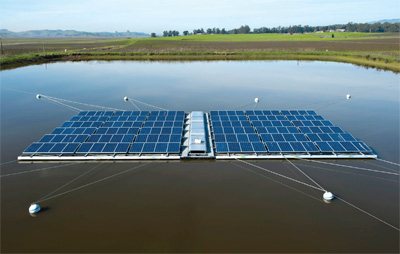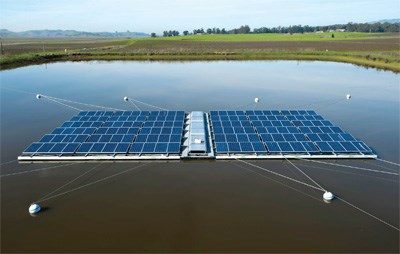
Finding a cost effective means to meet energy needs in remote mining areas is a million dollar question. Kim Trapani, an investigator with MIRARCO, thinks she has an answer. Trapani was recently recognized for the best student presentation at the 5th annual Mining and Environment International Conference held at Laurentian University in Sudbury in June.Trapani is a Ph.D. student at Laurentian University and works alongside MIRARCO Research Chair, Professor Dean Millar. They propose mounting photovoltaic (PV) solar panels on McFaulds Lake, an area poised to be the next major mining camp in Canada, to provide a secondary energy resource.
Solar panels are often found mounted on buildings or installed in fields, but there have only been a few applications where they are floated on water. R&D projects in Italy and California have demonstrated the viability of PV panels on small bodies of water.
PV systems convert sunlight into electricity. Their major benefit is their reliability, low maintenance and the fact that they don’t produce pollution. Installation is easy and they cost little to operate.
The PV system has a number of solar cells that are connected together into panels and arrays. The solar array is then connected to an inverter that converts the energy to the power system. The actual yield of a PV array is determined by its exposure to sunlight, packing density ratio, the project footprint, efficiency of the module and array transmission losses.
Floating panels
Trapani and Millar know that the McFaulds Lake area is a hotbed for future mining activity and regard it as an ideal location for floating PV panels because there are few buildings or flat land to install an array. The McFaulds Lake area sits in a remote part of the Hudson Bay Lowlands off the provincial power grid and with no road access.
Trapani demonstrated how a hypothetical mine operation at McFaulds Lake would benefit by using a floating PV array. She compared both thin film and crystalline panels that would float on the lake surface, moored to the bottom.
The capital costs are estimated at $227,000 for the thin film PVs and $329,000 for crystalline. These figures refer to the annuitized capital expenditure per MW of installed capacity. The annual operating and maintenance costs would be $1,800 for thin film and $2,700 for crystalline per MW of installed capacity.
“They could stay in place for 20 years,” explained Trapani. “They don’t need a lot of maintenance, there are no mechanical parts. Our research concept involves being able to roll up a panel to replace it.”
The panels are originally designed for sail boats and to resist any damage from water.
The system would not be connected to the Ontario grid. At this time, feed-in tariffs do not apply. However, this could change.
In countries such as the island of Malta, where Trapani is from, land is limited and using the water body is the only viable solution.
In the McFaulds Lake area, where there is an abundance of unused land, it is actually more efficient to use the lake.
Efficiency
“PV panels have negative temperature coefficiency,” explained Trapani. “They have a higher efficiency when they are cold rather than when they are hot. The lake acts like a heat sink and would take heat out of the panels and maintain them at higher efficiency.”
“Reliability is a key motivating factor for PVs because other competing technologies have far higher maintenance costs,” said Millar. “Nobody else is looking at solar energy in a marine context. That is why we believe our work is unique.”
The research compared four array sizes and two types of panels. Crystalline PV is more common because it has been around longer, while thin film PV is a newer technology.
The four array sizes were: 10 MW (the feed-in tariff maximum), 16 MW (mine base load), 20 MW (average rated power consumption) and 24 MW (peak power consumption), in all cases supplemented by diesel generators.
At the minimum 10 MW with diesel generation, there would be a saving of $9 million for thin film and $8 million for crystalline. The smaller PV installations save more based on the Ontario feed-in tariff applying at scales of up to 10 MW.
At peak power consumption (24 MW), the savings would be $7.7 million for thin film and $5 million for crystalline.
All calculations took into consideration the level of energy available, with a reduction factored in during winter months between November and March when panels are covered in snow and ice and the intensity of the sun is modest.
Trapani estimates that with 40 MW per square kilometre for thin film PV on McFaulds Lake, which is an area of about 10 square kilometres, the total installed capacity would be 400 MW. If each mine had a demand of around 25 MW, 16 mines could get power from the PV arrays.
In the next two years, they would like to work with a mining company to install a floating solar array and demonstrate the technology.



